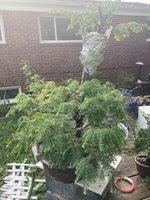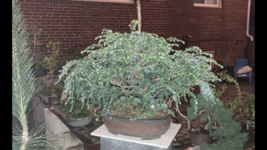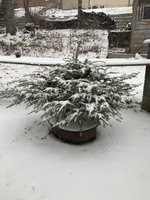You are using an out of date browser. It may not display this or other websites correctly.
You should upgrade or use an alternative browser.
You should upgrade or use an alternative browser.
Tsuga canadensis collected
- Thread starter MrFancyPlants
- Start date
MrFancyPlants
Omono
Real vigorous growth as you can see. The netting takes some aesthetics away, but I got to keep the cicadas off. It is much more effective now that they are done hatching for the most part, so don’t climb up from the bottom so much.
Once the cicadas are clear, I’ll clean up the surface soil and bring it down a bit in prep for next spring’s bottom to top repot To try and fit it in the S. Rayner pot.
Once the cicadas are clear, I’ll clean up the surface soil and bring it down a bit in prep for next spring’s bottom to top repot To try and fit it in the S. Rayner pot.
Attachments
MrFancyPlants
Omono
Looks like my air layer finally failed.. there was some callousing, but 0 roots.
In better news the tree itself is nice and healthy if a little oddly shaped from the cicada netting. @River's Edge do you thing I could get away with some root work this season, or wait until Spring?
In better news the tree itself is nice and healthy if a little oddly shaped from the cicada netting. @River's Edge do you thing I could get away with some root work this season, or wait until Spring?
Attachments
River's Edge
Masterpiece
If you try another air layer I would advise retaining as much foliage above the air layer as possible! It is the foliage that produces the energy for root growth. Reducing the foliage, reduces the strength of the response possible. That being said conifers can be very tricky with air layers and take several years to produce roots if at all.
Pictures do not depict a true enough gauge of the tree's health and at this point it is unclear to me how much work this tree has had done to it over the past year or two.
Personally I would wait till spring for beginning the repot process.
Pictures do not depict a true enough gauge of the tree's health and at this point it is unclear to me how much work this tree has had done to it over the past year or two.
Personally I would wait till spring for beginning the repot process.
MrFancyPlants
Omono
I just did a light surface weeding, with minimal combing, and placed fresh fertilizer tablets. Lots of nice back budding from letting it grow last year and then trimming hard over the winter. I’d back off this winter and give it a hard root prune to fit the new pot, if I can.. it may have to be done in stages over a couple years. Then next year about this time if it has responded well I may chase back to some interior growth and balance some branches if they are getting too heavy.If you try another air layer I would advise retaining as much foliage above the air layer as possible! It is the foliage that produces the energy for root growth. Reducing the foliage, reduces the strength of the response possible. That being said conifers can be very tricky with air layers and take several years to produce roots if at all.
Pictures do not depict a true enough gauge of the tree's health and at this point it is unclear to me how much work this tree has had done to it over the past year or two.
Personally I would wait till spring for beginning the repot process.
Attachments
MrFancyPlants
Omono
MrFancyPlants
Omono
Summer update. Lots of vigor going into a planned repot. I’m not sure I’ll risk a fall repot, although I have a feeling it would handle just fine, I just don’t want to risk with my only “Yamadori.” I’m also not sure if it qualifies as Yamadori, though I did personally collect from the mountains.
@River's Edge what do you think with the vigor and and the upcoming repot?
@River's Edge what do you think with the vigor and and the upcoming repot?
Attachments
hinmo24t
Masterpiece
lovely tree, got some good info in here, thanks.
ill take some photos of 3 yamadori i have later on, all under 18" tall but with great shape and a bit of girth.
my larger yamdori i posted in here before and they are all growing for a few years in their collected containers.
i think they are great looking trees! have a patch of them behind my house and elsewhere
ill take some photos of 3 yamadori i have later on, all under 18" tall but with great shape and a bit of girth.
my larger yamdori i posted in here before and they are all growing for a few years in their collected containers.
i think they are great looking trees! have a patch of them behind my house and elsewhere
River's Edge
Masterpiece
The tree definitely looks healthy enough to survive a fall maintenance or partial repot. I typically reserve full repots for spring with my hemlocks if I expect to do considerable root work. If I am doing partial repots 30% or less then I take advantage of the fall repotting window to progress toward completing the full repot cycle, changing out old soil.So if just a normal maintenance repot of an established tree, go for it. If expecting to do major work 50 % or more on the root ball to progress towards an established bonsai root system I would wait for spring. I note you are in a little cooler zone than me.Summer update. Lots of vigor going into a planned repot. I’m not sure I’ll risk a fall repot, although I have a feeling it would handle just fine, I just don’t want to risk with my only “Yamadori.” I’m also not sure if it qualifies as Yamadori, though I did personally collect from the mountains.
@River's Edge what do you think with the vigor and and the upcoming repot?
The simple reasoning is I prefer to keep the tree stronger going into the winter in case the recovery time is shortened by early cold or freezing temperatures. Hemlock require consistent wiring and I prefer to use the fall/winter for that activity. Major repot in the fall would delay the wiring and fall pruning in my schedule.
Caveat: I tend to take care as opposed to more aggressive approaches. Work within your comfort zones and note the recovery time. My preference is for faster recovery times and thus healthier trees ready for more consistent improvement. Hope the rambling makes sense!
MrFancyPlants
Omono
Yup, makes perfect sense. My avg first frost date is Oct 21, so I was thinking if I repotted now there would be plenty time for recovery, but as I said, not looking to play it risky with this one, and fitting in the smaller pot will be a big enough operation that it may take a couple rounds of repotting in order to get it to fit the new pot.The tree definitely looks healthy enough to survive a fall maintenance or partial repot. I typically reserve full repots for spring with my hemlocks if I expect to do considerable root work. If I am doing partial repots 30% or less then I take advantage of the fall repotting window to progress toward completing the full repot cycle, changing out old soil.So if just a normal maintenance repot of an established tree, go for it. If expecting to do major work 50 % or more on the root ball to progress towards an established bonsai root system I would wait for spring. I note you are in a little cooler zone than me.
The simple reasoning is I prefer to keep the tree stronger going into the winter in case the recovery time is shortened by early cold or freezing temperatures. Hemlock require consistent wiring and I prefer to use the fall/winter for that activity. Major repot in the fall would delay the wiring and fall pruning in my schedule.
Caveat: I tend to take care as opposed to more aggressive approaches. Work within your comfort zones and note the recovery time. My preference is for faster recovery times and thus healthier trees ready for more consistent improvement. Hope the rambling makes sense!
Tentative plan will be:
Major repot in Spring ‘22, removing 50-60% of root mass, likely back into same pot unless the stars are in alignment.
Major cut back winter ‘22
Minor repotting to fit new pot, fall ‘23 or spring ‘24 (if required)
Of course I’m not always great at following a plan, I am already tempted to at least cut back the top to let some light into the interior.
River's Edge
Masterpiece
Not sure if I mentioned this previously but a good step with Hemlock is a slow reduction from the top during the growing season. Essentially removing some of the surface roots as you work your way down to the base nebari that you desire. This accomplishes two things, the baseline for the nebari. And this is important for establishing the amount of reduction required off of the bottom to fit the various stages of reduction. The second is to strengthen the lower portion of the root mass that will eventually support the tree.Yup, makes perfect sense. My avg first frost date is Oct 21, so I was thinking if I repotted now there would be plenty time for recovery, but as I said, not looking to play it risky with this one, and fitting in the smaller pot will be a big enough operation that it may take a couple rounds of repotting in order to get it to fit the new pot.
Tentative plan will be:
Major repot in Spring ‘22, removing 50-60% of root mass, likely back into same pot unless the stars are in alignment.
Major cut back winter ‘22
Minor repotting to fit new pot, fall ‘23 or spring ‘24 (if required)
Of course I’m not always great at following a plan, I am already tempted to at least cut back the top to let some light into the interior.
This often a needed stage with collected trees as the most desirable nebari are often below the surface, which means establishing a lower root ball over time and decreasing reliance on the surface roots slowly over time.
Often a great opportunity to increase flare and movement at the base before finalizing repotting angle and design possibilities.
From the pictures I cannot tell if your tree would benefit from this, but I suspect it might particularly on the right side ( picture one)
As a beginning guideline I would target 1/2 inch every couple of months until the desired base is achieved. But not in combination with a repot.
" tempted to at least cut back the top to let some light into the interior"
good idea, often just thinning the foliage will accomplish the same thing, ensuring that the closest in foliage remains healthy!
MrFancyPlants
Omono
I had planned on removing a few “flying roots” on the side you mentioned. It’s funny, but I think you talked me out of attempting that this year. Your (I believe valid) rational was that I should see what is going on from the bottom first, to make sure I had a better base to work down to, before removing roots from the top.Not sure if I mentioned this previously but a good step with Hemlock is a slow reduction from the top during the growing season. Essentially removing some of the surface roots as you work your way down to the base nebari that you desire. This accomplishes two things, the baseline for the nebari. And this is important for establishing the amount of reduction required off of the bottom to fit the various stages of reduction. The second is to strengthen the lower portion of the root mass that will eventually support the tree.
This often a needed stage with collected trees as the most desirable nebari are often below the surface, which means establishing a lower root ball over time and decreasing reliance on the surface roots slowly over time.
Often a great opportunity to increase flare and movement at the base before finalizing repotting angle and design possibilities.
From the pictures I cannot tell if your tree would benefit from this, but I suspect it might particularly on the right side ( picture one)
As a beginning guideline I would target 1/2 inch every couple of months until the desired base is achieved. But not in combination with a repot.
When I collected, I seem to remember a much better base down below, but wanted to preserve every root I could at collection. I recall a wagon wheel of thick roots, but I didn’t take pictures, and sawed through them to collect, so they may not have survived.
A few years ago I decided to add soil to the bottom of the pot, in a misguided attempt to facilitate removal of the upper roots by exposing them. I realize now that it was likely counter productive.
I will likely remove those upper roots yet, but I think after I do the major, Spring, repot focusing on removing roots from directly under the trunk. Depending on how it goes, I can remove the flying roots then, or save them for gradual reduction, over the next year, if it is too much root work to do both at one time.
hinmo24t
Masterpiece
ironically the one on the far left i had got rid of some surface roots -for better or worse- when i first transplanted it from the wild.I had planned on removing a few “flying roots” on the side you mentioned. It’s funny, but I think you talked me out of attempting that this year. Your (I believe valid) rational was that I should see what is going on from the bottom first, to make sure I had a better base to work down to, before removing roots from the top.
When I collected, I seem to remember a much better base down below, but wanted to preserve every root I could at collection. I recall a wagon wheel of thick roots, but I didn’t take pictures, and sawed through them to collect, so they may not have survived.
A few years ago I decided to add soil to the bottom of the pot, in a misguided attempt to facilitate removal of the upper roots by exposing them. I realize now that it was likely counter productive.
I will likely remove those upper roots yet, but I think after I do the major, Spring, repot focusing on removing roots from directly under the trunk. Depending on how it goes, I can remove the flying roots then, or save them for gradual reduction, over the next year, if it is too much root work to do both at one time.
these 3 have been doing well, they had a bit of a hot day in the photos
i had these in 50% + shade under breezeway often for first few mos but they have been out in sunlight
more and more.
just trying to beef these up for a few years but i do love their shapes
one or two of these were actually growing out of an old rotten tree stump
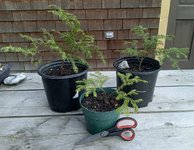
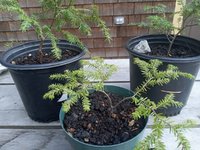
River's Edge
Masterpiece
I should have reviewed the past history, for some reason I thought you had dealt with the bottom. The best approach is to determine the overall condition before reducing the surface roots for Hemlock. This is contrary to most species but important. The condition of the tree would seem to indicate a pretty full root ball but actually seeing the strong areas versus the weak areas is the most important first step. Thanks for reminding me.I had planned on removing a few “flying roots” on the side you mentioned. It’s funny, but I think you talked me out of attempting that this year. Your (I believe valid) rational was that I should see what is going on from the bottom first, to make sure I had a better base to work down to, before removing roots from the top.
When I collected, I seem to remember a much better base down below, but wanted to preserve every root I could at collection. I recall a wagon wheel of thick roots, but I didn’t take pictures, and sawed through them to collect, so they may not have survived.
A few years ago I decided to add soil to the bottom of the pot, in a misguided attempt to facilitate removal of the upper roots by exposing them. I realize now that it was likely counter productive.
I will likely remove those upper roots yet, but I think after I do the major, Spring, repot focusing on removing roots from directly under the trunk. Depending on how it goes, I can remove the flying roots then, or save them for gradual reduction, over the next year, if it is too much root work to do both at one time.
Good time to remind any readers that the plan is always subject to what one finds upon exploration. Decision of how to proceed needs to include how much is still required and the current timing and condition. typical response for Hemlock when thick roots are chopped is to send lots of small roots from the cut site. The some pictures of what you find when you get there.
MrFancyPlants
Omono
The root ball is full, that is for sure. As to balance or design, it may as well be Schrödinger's bonsai pot. I wonder if I should get a sawsall before Spring?The condition of the tree would seem to indicate a pretty full root ball but actually seeing the strong areas versus the weak areas is the most important first step.
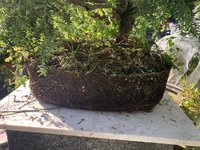
MrFancyPlants
Omono
MrFancyPlants
Omono
I went to a NVBS (northern Virginia) repotting workshop this morning, to make the move into my Sara Rayner pot. But, it was canceled due to weather with no notice, so I drove this and a juniper around in the snow for an hour. Oh well, I have what I need to repot myself. I just thought it would be fun to do it in a group setting. This way there is less likelihood of someone braking off some of the flakey bark while showing off to new members (happened before).
Attachments
BrightsideB
Omono
Beautiful tree! Looking really nice! I’m hoping this is the last cold front here in north Georgia. Had to bring some trees in that I had repotted.
Japonicus
Imperial Masterpiece
Nice looking pot. Just got a SR cascade pot a couple weeks ago

The cancellation sucks though.
The cancellation sucks though.
MrFancyPlants
Omono
I got it done today.. it is still a little more mounded than I prefer, but I’ll call it a successful transition, assuming it leafs out well this year. I didn’t really find that wagon wheel of roots under there that I recall from collection… yet. I’m going to focus on the top for a few years (once it shows strong growth of course) and then I can try to shallow out the roots a bit more.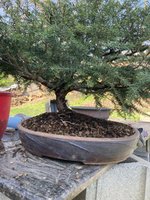
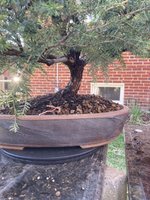
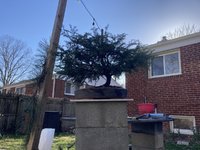



Attachments
-
 B5D013A5-4F6A-4A8D-9A1E-1002810AEE18.jpeg380 KB · Views: 23
B5D013A5-4F6A-4A8D-9A1E-1002810AEE18.jpeg380 KB · Views: 23 -
 A8547F67-2960-48A9-9CB9-9F8F1AB387AC.jpeg346.5 KB · Views: 20
A8547F67-2960-48A9-9CB9-9F8F1AB387AC.jpeg346.5 KB · Views: 20 -
 44385832-A0B1-463D-A4F7-A894D8D460FD.jpeg440 KB · Views: 20
44385832-A0B1-463D-A4F7-A894D8D460FD.jpeg440 KB · Views: 20 -
 C7F03403-D3C8-4BFF-ADB2-29AF21672A85.jpeg368.9 KB · Views: 20
C7F03403-D3C8-4BFF-ADB2-29AF21672A85.jpeg368.9 KB · Views: 20 -
 A2C883B2-E57B-4988-9B89-7CAD6F82F1EC.jpeg414.9 KB · Views: 21
A2C883B2-E57B-4988-9B89-7CAD6F82F1EC.jpeg414.9 KB · Views: 21
Similar threads
- Replies
- 17
- Views
- 3K
- Replies
- 19
- Views
- 2K

